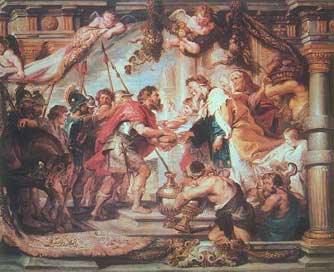
A text from the Talmud sets the latest possible date for Hebrews. R. Ishmael died c. 135 CE; if these are his words, the composition of Hebrews (to which Ishmael refers) must have taken place before his death.
R. Zechariah said, in the name of R. Ishmael,
The Holy One - blessed be He - sought to cause the priesthood to go
forth from Shem.
For it is said:
And he was a priest of God Most High. [Gen 14:18]
As soon as he put the blessing of Abraham before the blessing of
God, he caused it to go forth from Abraham, as it is said,
And he blessed him and said:
Blessed be Abraham of God Most High, possessor of
heaven and earth, and blessed be God Most High. [v.19]
Abraham said to him:
Do they put the blessing of the servant before the
blessing of his owner?
Immediately it was given to Abraham, as it is said:
The Lord says to my Lord:
Sit thou at my right hand until I make thy
enemies a footstool for thy feet. [Ps. 110:1]
And further down it is written,
The Lord hath sworn and will not repent,
Thou art a priest forever after the order of
Melchesidek, [v.4] according to the saying of Melchesidek.
And this is what is written.
And he was priest of God Most High. [Gen 14:18]
He was priest; his seed were not priests.
Babylon Talmud, Nedar. 32b, quoted in Travers R. Herford, Christianity in Talmud and Midrash, 1903, I, b, iv; pg 338, item 139.
Hebrews was clearly known to the author of 1 Clement (17:1, 36:2-5). This sets the terminus ad quem for the book of Hebrews. However, dating 1 Clement is difficult, with commentators ranging from 95 CE to 120 CE or even as late as 140 CE.
Attridge states on the dating of Hebrews (The Anchor Bible Dictionary, v. 3, p. 97):
Within the broad range of the years 60-95 C.E., various conjectures have been made about a more precise dating. References to the Jewish sacrificial cult in the present tense (9:6-10; 10:1-4), along with the lack of any mention of the destruction of the temple, have been taken as evidence of a date prior to 70 C.E., when the Jerusalem temple was destroyed. This argument, however, is inconclusive, since our author is not at all concerned with the Herodian temple. Rather, he deals with the desert tabernacle and argues exegetically from biblical data. Moreover, authors writing after 70 C.E., such as Josephus, Clement of Rome, and the compilers of the Mishnah, often refer to the temple as a present reality.
Kummel dates Hebrews as follows (Introduction to the New Testament, p. 403): "To the obvious question whether Jerusalem is still standing (13:13 f) and the temple cultus is still in process (9:9 f) Heb gives no answer. In its timeless scholarly movement of ideas only the OT sanctuary plays a role, not the Herodian temple; an origin before 70 cannot be inferred either from the silence concerning the catastrophe of the year 70 or from the expression in 8:13 that the Old Covenant is 'in the course of passing away.' On the contrary, the persecutions which the community has experienced (10:32-34) and the spiritual proximity to Lk-Acts point in all probability to the post-Pauline period. Heb was, however, written before 96 (I Clem); Timothy, who as a young man had been a mission aide of Paul, is still living (13:23), writers and readers belong to the second Christian generation (2:3), the new suffering which threatens the readers (12:4) may point to the time of Domitian (81-96). Accordingly the letter was probably written between 80 and 90."
Hebrews 2:3 states: "Announced first by the Lord, it [salvation] was confirmed to us by those who had heard him." Hebrews 13:7 states: "Remember your leaders who spoke the word of God to you; consider how their lives ended, and imitate their faith." This is compatible with a date of Hebrews during the second or third Christian generation.
Harold W. Attridge writes of the Epistle to the Hebrews (op. cit., p. 97):
Although Hebrews is included in the Pauline corpus and was part of that corpus in its earliest attested form (p46), it is certainly not a work of the apostle. This fact was recognized, largely on sytlistic grounds, even in antiquity. Some patristic authors defended the traditional Pauline attribution with theories of scribal assistants such as Clement of Rome or Luke, but such hypotheses do not do justice to the very un-Pauline treatment of key themes, particularly those of law and faith. Numerous alternative candidates for authorship have been proposed. The most prominent have been Barnabas, to whom Tertullian assigned the work; Apollos, defended by Luther and many moderns; Priscilla, suggested by von Harnack; Epaphras; and Silas. Arguments for none are decisive, and Origen's judgment that "God only knows" who composed the work is sound.
The book is anonymous, and its author is unknown. Perrin writes about the provenance of Hebrews (The New Testament: An Introduction, p. 138): "To whom was Hebrews originally addressed? The writer is a Hellenistic Jewish Christian, and his arguments presuppose that he is writing to others who think as he does, i.e., to a Hellenistic Jewish Christian community. Since Clement of Rome knows and quotes the text within what could only have been a few years of its writing, that community may well have been in Rome. This view is supported by the greetings from 'those who have come from Italy' in Heb 13:24."
Go to the Chronological List of all Early Christian Writings
Please buy the CD to support the site, view it without ads, and get bonus stuff!
Early Christian Writings is copyright ©
Peter Kirby <E-Mail>.
Kirby, Peter. "The Book of Hebrews." Early Christian Writings. <http://www.earlychristianwritings.com/hebrews.html>.